



 |
 |
|
 |
||
 |
||
Vol. 13 (1): June 2010 |
||
Seal numbers continue to dive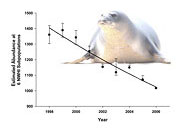 NOAA Fisheries biologists recorded the lowest Hawaiian monk seal pup count in a decade during the 2009 breeding season. In the Northwestern Hawaiian Islands (NWHI), most of which is contained within the Papahanaumokuakea Marine National Monument, researchers counted 119 pups, compared to 138 in 2008. Charles Littnan, lead scientist in NOAA’s Hawaiian Monk Seal Research Program, expressed disappointment in the results, stating that “The biggest problem is poor juvenile survival. Less than 1 in 5 pups that are born live to adulthood.” A large number of juveniles, he added, are starving to death, despite the protection offered by the Papahanaumokuakea Marine National Monument. Although researchers are still unable to pinpoint with certainty a single threat or a combination of factors responsible for the seal’s tailspin into extinction, Littnan maintains that, ecologically, Papahanaumokuakea is not as pristine as appearances or popular opinion would suggest, having suffered “hundreds of years of disturbance”. Such imbalances, he went on, might be causing younger and inexperienced monk seals to lose out in competition over the same prey with other apex predators, such as sharks and ulua (Caranx ignobilis), a species that has adapted the hunting technique of pursuing foraging monk seals and ‘stealing’ the prey they flush out.
As reported in previous issues of TMG, pup production at French Frigate Shoals has been hit hard by attacks from patrolling Galapagos sharks. NOAA reports that up to 35% of pups born at the shoals are lost as a result, with sharks attacking the still-nursing animals in as little as 5 centimetres of water. Previous efforts to eliminate patrolling sharks have led to controversy, while efforts to drive sharks away rather than kill them using amplified boat engine noise and electromagnetic arrays, have proved unsuccessful, admits Littnan. The US Marine Mammal Commission, in a March 2010 letter [PDF However, the plan to eradicate sharks remains highly contentious among some academics, as well as ecologists who argue that such interventions will do nothing to restore the natural ecological balance of the NWHI. An alternative strategy pursued by NOAA in the interim has instead focused on deworming in order to strengthen pups against parasite infection, and translocation to Laysan Island, where the Galapagos shark threat is minimal.
As a result of these and other threats, such as entanglement and drowning in discarded fishing gear, the Hawaiian monk seal continues to decline at an alarming rate of 4% a year, and may plunge through the psychologically important 1,000 mark within 3-4 years. In contrast to the NWHI, the Main Hawaiian Islands, says Littnan, offer something of a ray of hope for the continued survival of the species, with the population now reaching a hundred plus. During 2009 counts, 6 births were reported on Molokai, 5 on Kauai, and 2 each on Oahu and Maui. The species, however, continues to face varied threats on the heavily developed Islands, including entanglement and drowning in gill nets, injury from fishing hooks, deliberate shooting incidents, as well as the perils posed by too close a contact with humans – that might just earn the offending animal a one-way ticket to the aquarium. Further informationNOAA. 2009. Field season for Hawaiian monk seal population research draws to close. Quarterly Research Bulletin / October 2009. NOAA Pacific Islands Fisheries Science Center. Wilson, Christie. 2009. Fewer Hawaiian monk seal pups, Honolulu Advertiser, February 1, 2010.
|
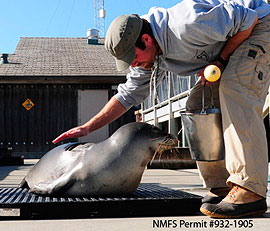 |
|
|
Head trainer Beau Richter has Hō'ailona lie on a platform scale so researchers can weigh him. |
Diagnosis of cataracts in both eyes and diminishing eyesight led NOAA officials to intervene by taking the pup into captivity. The move provoked public anger on Molokai, where KP2 had become something of a celebrity [see Short-lived freedom for KP2, TMG 12(2): 2009 and Freedom at last for KP2, TMG 12(1): 2009], and even unprecedented demonstrations outside the Waikiki Aquarium.
KP2 has now been renamed Hō‘ailona (Hawaiian for “a sign from the ocean”). Researchers at the Marine Mammal Physiology Project state that the seal will be studied to yield insights into “the energetic needs of Hawaiian monk seals”, and point to – as yet hazy – conservation benefits for the species.
A press release issued by the University on 18 March states that “Williams is particularly interested in conducting basic metabolic studies that will help researchers understand how much energy a monk seal has to expend to find food and thrive in different environments. In the controlled environment at Long Marine Lab, researchers can measure Ho’ailona’s oxygen consumption and calculate how much energy he expends per swimming stroke. They can also study his responses to different water temperatures. […] Williams hopes to learn how sensitive monk seals are to changes in ocean temperature. This is important for understanding how vulnerable the species may be to climate change, she said.”
Beyond an acknowledgement of the possibility, there has been no indication as yet when Hō‘ailona may receive surgery to remove the cataracts that are affecting both eyes.
Hō‘ailona’s Journal. A new web site at UCSC to follow Hō‘ailona’s progress.
Ho'ailona Monk Seal. A Facebook page dedicated to Hō‘ailona, also run by UCSC.
Schofield, D., G. Levine, F. Gulland and C. Littnan. 2009. The first rehabilitation and release of an abandoned endangered Hawaiian monk seal (Monachus schauinslandi) pup in the Main Hawaiian islands. Poster presentation, in: Workshop "Research, Management, Conservation, and Policy in Monk Seal Recovery: A Global Perspective", 18th Biennial Conference of the Society for Marine Mammalogy. 10th October 2009, Quebec, Canada. [PDF  552 KB]
552 KB]
Schofield, D. 2009. Freedom at last for KP2. The Monachus Guardian 12 (1): June 2009.
TMG. 2009. Short-lived freedom for KP2. 12 (2): November 2009.
The 90-day imprisonment and $25 fine imposed on a Kauai man convicted of the shooting death of a pregnant Hawaiian monk seal in May 2009 [see Killings on Kauai, TMG 12(2): November 2009] drew widespread criticism at the time for its perceived leniency. That, in turn, also spurred the state legislature to draft tougher penalties.
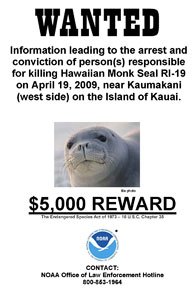 |
|
|
|
Reasoning that the existing misdemeanour penalty is insufficient to deter repeat offences in the future, Hawaiian legislators drafted a bill that would make the harming, killing or harassing of a monk seal a felony punishable by up to one year in jail and a $50,000 fine.
Senate Bill 2441 was passed unanimously by the state House and Senate in mid-April, and sent to the office of Governor Linda Lingle for further action.
Three known monk seal killings have occurred on the Main Hawaiian Islands of Kauai and Molokai since 2009. The killing of a 4-year old male seal in April 2009 remains under federal investigation, with a reward of $30,000 now being offered for further information on the perpetrator(s), increasing substantially the original $5000 offered by NOAA. The latest deliberate killing occurred on or around 14 December on Molokai, with NOAA officials announcing that the large male seal identified as R019 had been deliberately shot.
NOAA officials in Hawaii have voiced guarded support for the planned increase in legal penalties, though with animosity towards the species on the rise in certain parts of the MHI, has reiterated its view that community outreach and education may ultimately prove the most effective protector of the monk seal.
NOAA seal staff and NGOs are having to counter the growing misconception among some Hawaiian communities that the monk seal is an alien, non-native species.
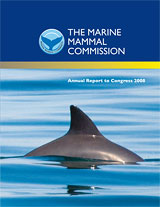 |
|
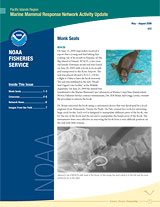 |
Marine Mammal Commission. 2009. Annual Report to Congress 2008. Marine Mammal Commission, Bethesda, Maryland: 1-282. [PDF  4.4MB]
4.4MB]
The Marine Mammal Commission’s Annual Report to Congress for 2008 was published in November last year. For those interested in Hawaiian monk seal population trends, human and natural threats to the species, as well as efforts underway to stem the species’ continuing decline, the MMC’s annual report remains an indispensable guide. The current edition assesses conservation efforts led by NOAA agency NMFS, in addressing the multiple threats that are currently reducing monk seal numbers by 4% per year. Within the NWHI, where the population fell below the 1,000 mark in 2007 for the first time, these measures include: Increasing juvenile survival, reducing shark predation and lessening the impact of marine debris. The report also assesses the current state of play for the monk seal in the Main Hawaiian Islands, where the monk seal is showing unexpected signs of recovery yet faces different threats.
NOAA. 2010. Pacific Islands Region Marine Mammal Response Network Activity Update, Volume 12, May – August 2009. [PDF  2.4MB]
2.4MB]
January 2010 saw the publication of the NOAA’s Marine Mammal Response Network Activity Update (Pacific Islands Regional Office), a newsletter focusing on marine mammal rescue, monitoring and monk seal pupping around the Main Hawaiian Islands, as well as efforts to limit human-seal interactions. The current edition covers the May-August 2009 period and, among other issues, focuses on monk seal births during the 2009 pupping season, and use of a specially designed instrument to remove fishing hooks from the mouths and throats of monk seals.
Gillnet proves deadly for female monk seal
 |
|
|
RA14, found entangled in a gillnet. |
The state Department of Land and Natural Resources is investigating the apparent drowning of a 9 1/2 -month-old Hawaiian monk seal that was discovered tangled in a gillnet – the sixth such death since 1976.
At 10:26 a.m. Tuesday, the female monk seal, identified by scientists as RA14, was spotted floating off Bellows Beach. Lifeguards discovered the seal wrapped in a monofilament gillnet and pulled her from the water.
Necropsy results determined the seal, nicknamed Mikala, died of an apparent drowning due to the entanglement. [...]
The Conservation and Resources Enforcement Division seized the netting as part of its investigation. It is unknown who owns the net.
Under state law all lay nets must be registered with the Department of Land and Natural Resources. It is unlawful to leave a lay net unattended for more than a half-hour. Nets also must be inspected within two hours after they are set.
Hawaiian monk seals are protected under the U.S. Endangered Species Act. Killing one is punishable by up to a year in jail and a $50,000 fine. [...]
Gillnet proves deadly for female monk seal, Honolulu Star Bulletin, 16 April 2010.
High-tech transmitters giving up secret lives of Hawaiian seals
Navy pays for devices that also gauge how sonar affects species
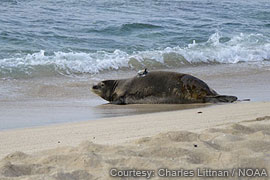 |
|
|
Hawaiian monk seal ‘Kermit’, equipped with mobile phone tag. |
Up to 15 monk seals in Hawai’i will be doing their part over the coming year to help scientists understand them better.
The critically endangered animals will wear small transmitters that reveal their movements, including how deep they dive, when they haul out on land and how far they roam.
Accumulating normal habits of the seals also will be used to gauge the effect Navy training exercises, including use of sonar, may have on the animals.
The Navy is footing the bill for the $4,500-each transmitters, NOAA scientists’ travel and veterinary costs associated with the project. The project is slated to last several years.
Currently five seals are wearing the transmitters – one on O’ahu and four on Moloka’i. Additional transmitters will be placed on 10 more seals on Kaua’i and O’ahu in coming months, said Charles Littnan, lead scientist for NOAA Fisheries’ Hawaiian Monk Seal Research Program. […]
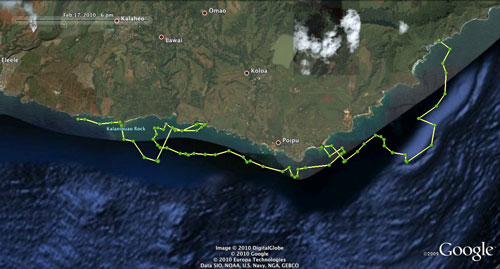
Kermit, an adult male monk seal, was tracked for three days along the south shore of Kauai.
The line shows his path; each dot is a location. Kermit dived 100 to 150 feet and surfaced about every six minutes.
Courtesy: Charles Littnan / NOAA
The transmitters “are a lot like a smartphone,” Littnan said. They show a seal’s location with global positioning coordinates and also track water temperature, salinity and depth of dives. They “phone home” when the seals are on the surface of the water or on land and the devices can transmit via a cell phone tower, Littnan said. [...]
High-tech transmitters giving up secret lives of Hawaiian seals, Diana Leone, Honolulu Advertiser, 11 April 2010.
~ Other News Watch items are carried on our TMG News blog ~
EndQuoteUnsuspecting tourists A dozen years ago I met a strapping young man, just out of high school and working as first mate on a snorkel cruise boat. Much to my amazement, one of his duties on daily excursions to Molokini was to discourage a rambunctious teenage monk seal, known for making amorous advances on unsuspecting tourists. I had read about "Humpy," as the seal was dubbed, and his interactions with surprised swimmers, mainly in the Makena area of South Maui. Agencies responded to the ongoing incidents by relocating the frisky seal to Kaho'olawe. But within days, the seal had returned and was frequenting Molokini islet, with its hundreds of daily snorkelers and divers. While some visitors were undoubtedly thrilled to encounter the rare pinniped, they may not have been aware of the dangers associated. To humans, yes, as seals are known to nip or bite. But much more so to the seal. […]
|
Copyright © 2010 The Monachus Guardian. All Rights Reserved |